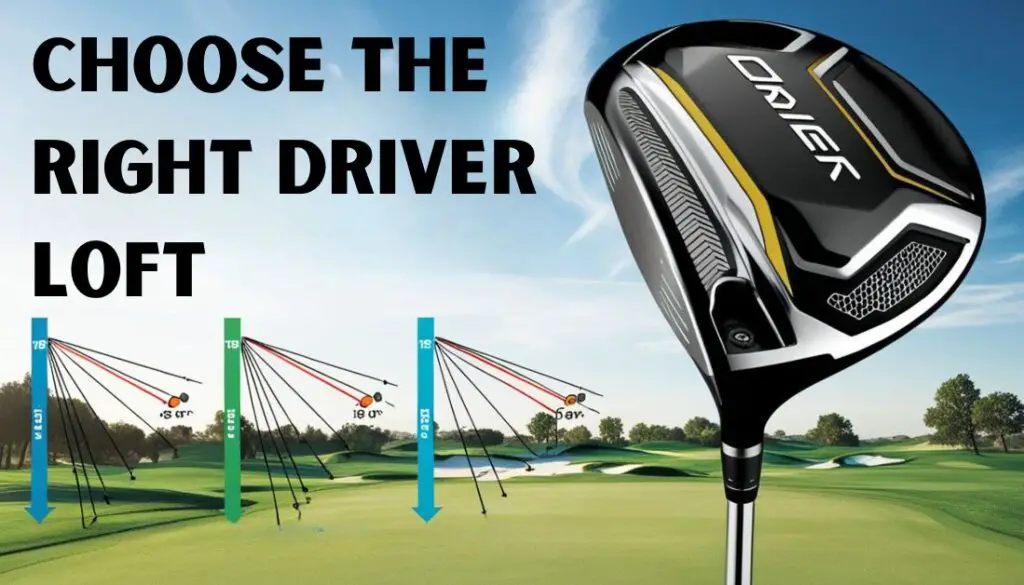One of the most important factors is choose the right driver loft in optimizing your tee shots and also the right golf equipment is essential. The driver is typically the longest-hitting golf club in your bag, used on most holes when playing from the tee. To maximize your potential on the golf course, having the correct loft is essential for yardage and accuracy. Even if you’ve invested over $500 in the best drivers, without the optimal loft, you might leave valuable performance on the table. A visit to your local PGA professional for a thorough custom fitting session with the help of launch monitors can help identify the best loft for your driver.
The loft you choose can significantly influence the ball’s flight and how your ball moves through the air. With loft angles typically ranging from 7.5 to 14 degrees of loft, this aspect of the golf club will impact the trajectory, distance, and control of your drives. By considering your swing speed and angle of attack, you can find the right loft to improve accuracy and add yards to your game. This is especially true with advancements in driver technology that offer more flexibility and control, helping golfers refine their specifications for the ultimate driver setup
Table of Contents
ToggleWhat Is Driver Loft And Why Is It Important?

The angle of the clubface that affects how high the ball launches when hit is referred to as driver loft. For drivers, it usually varies between 8 and 14 degrees when expressed in degrees. The loft is a significant factor in determining the shot’s height and distance. Your ball may not get enough lift if your loft is too low, and it may lose distance if it is too high. For this reason, choosing the appropriate loft is crucial to optimizing your performance.
Loft is particularly significant since it directly affects the ball’s path. Higher lofts are frequently necessary for players with slower swing speeds, for example, to help get the ball flying and increase carry and total distance. On the other hand, players who swing the ball faster can gain from a lower loft since their speed naturally generates enough lift to have the ball travel farther. By effectively matching your swing characteristics with the ideal ball trajectory, the proper driver loft makes sure you maximize every drive.
How To Choose The Right Driver Loft
To pick the right loft for your golf driver, understanding your swing speed is key. Getting a Trackman fitting with a professional is the best way to figure this out, but if you can’t, you can still estimate it. Start by hitting a club you can send 150 yards. If it’s a 7-iron, your swing speed is between 95 and 104 mph. For every club length you move up, you subtract 5–10 mph, and for every length down, you add 5–10 mph. For example, if you’re hitting an 8 iron for 150 yards, your swing speed might be between 104 and 114 mph.
Once you know your swing speed, use the table to match it with the ideal loft. For example, at 85 mph, you need a loft angle between 14 and 20 degrees, while at 105–115 mph, you’d want something between 7 and 9 degrees. Players with lower swing speeds often prefer higher lofts for added spin rate and launch to get the ball higher in the air. Less experienced players may also find that higher launches give them more distance and consistency, whereas skilled players usually stick with less lofts.
If you’re new to the game, going with a higher loft can make your life easier, while advanced golfers might prioritize control with a lower loft.
Which Factors Impact Driver Loft Angle

Swing speed and angle of attack are two key factors that impact your driver loft. Faster swing speeds above 105 mph require lower lofts to achieve optimum distance. This is because the faster you swing, the more the club compresses the ball against the face, increasing ball speed. A lower loft prevents the launch angle from getting too high.
On the other hand, slower swing speeds below 90 mph benefit from higher lofts to help lift the ball into the air. The angle of attack also plays a role. A positive angle, where the clubhead strikes the ball in an upward motion, requires a higher loft to avoid too much height. In contrast, a negative angle means the clubhead hits the ball in a downward motion, so a lower loft helps to increase the launch angle.
Your Flight Path
The loft angle of the golf driver has a big impact on your ball’s flight path. Golfers who swing slowly find that a higher loft yields a higher trajectory, which gives the ball more carry through the air. On the other hand, a lower loft results in a more penetrating flight path that requires less height but has greater rollout once the ball falls. This usually helps faster-swinging golfers since their inherent speed generates enough lift to optimize distance without compromising control.
Swing Characteristics
Your swing attributes swing speed, angle of attack, and consistency of ball strike directly affect which driver loft you need to be using. Faster swinging golfers typically like a lower loft (8–10 degrees) since they already have sufficient force to move the ball skyward. Golfers who swing the club slower—below 80 mph—need to use a higher loft—12 to 14 degrees—to increase carry distance and launch angle. A lower loft can also increase the distance if you often hit the ball on an upswing, whereas higher lofts are better for golfers who smash the ball down.
By Design
Driver design plays a major role in determining the loft and how your ball flight behaves. Modern drivers use lighter materials like carbon-composite crowns on the top of the golf driver and strategic weight-savings in various parts of the club head. These changes impact the center of gravity (CG), creating a more forgiving design that affects ball-flight heights.
By moving the weight further back and away from the face, off-center strikes lead to fewer misses and more distance. Features like face curvatures, twist face technology and expanded hitting areas alter how the ball reacts on different parts of the face. The golf driver shaft, a graphite wand, transfers your swing’s energy to the driver’s head, influencing the ball’s flight trajectory based on its weight, torque, shaft flex, and shaft bend points.
Course Conditions
Course conditions also play a vital role in determining the optimal golf driver loft. On wet or soft fairways, a higher loft may help maximize carry distance since the ball won’t roll much after landing. In contrast, on firm or dry courses, a lower loft could be advantageous because the ball will roll further after impact. Wind conditions can also dictate loft choice. For example, a higher loft can be risky in strong headwinds as it increases the chance of the ball ballooning, while a lower loft can cut through the wind more effectively.
To choose the right driver loft, consider a new driver like a TaylorMade that offers low spin and a higher launch, ideal for golfers with an upward angle of attack
Pros And Cons Of Higher Driver Loft

Choosing a higher driver loft has both advantages and drawbacks, depending on your skill level, swing speed, and playing conditions. Understanding these pros and cons can help you make an informed decision when selecting the right loft for your game.
Pros Of Higher Driver Loft
Increased Launch Angle: A higher loft makes it easier to get the ball airborne, which is beneficial for golfers with slower swing speeds.
Improved Carry Distance: The added loft helps achieve greater carry distance, which is crucial for players who struggle to generate lift.
Better Control in Wind: A higher loft can stabilize the ball’s flight in windy conditions, making it easier to manage.
Cons Of Higher Driver Loft
Potential Loss of Total Distance: Higher loft often results in reduced rollout after landing, which can decrease overall driving distance.
Excessive Backspin: Players with a strong, fast swing might experience too much backspin, causing the ball to balloon and lose distance.
Less Roll: The increased launch angle can reduce the amount of roll after the ball lands, impacting the total distance on firm fairways.
Summary
When selecting the right golf driver loft, consider its crucial role in your tee game. For many amateur golfers with a 14+ handicap, a higher loft can enhance both distance and accuracy. Since most drivers are adjustable, experimenting with different settings can reveal how varying loft affects your distance and trajectory.
For single-digit handicap golfers and scratch golfers, driver loft is just one element of the equation. Factors like dynamic loft, attack angle, and launch angle are also essential. Utilizing a launch monitor and getting a professional fitting can ensure that your driver is dialed in perfectly. Regardless of your skill level, don’t hesitate to experiment with different lofts, club heads, and driver shafts to find what’s optimized for your game.
Read More: Choosing the Best Loft Angle for Your Driver
FAQ's
Spin loft is a term you’ll often hear in discussions about club optimization, and it’s more than just an angle – it’s the relationship between various factors like dynamic loft and attack angle. As explained by Peter Field Golf, this three-dimensional angle describes how the club head is moving through the ball’s direction about the club face and how it’s pointing at impact. Essentially, spin loft combines both the club path and face angle, along with the dynamic loft, to create the ideal flight path for your ball. Finding the right balance in these angles can help you get the most out of your swing
For golfers who are just beginning the game, especially those with slower swing speeds under 80mph, it’s crucial to maximize your carry distance. This is why using driver lofts of around 12 to 14 degrees is often recommended. As a beginner, you want the ball to stay in the air longer, giving you more distance and making the game more enjoyable. Choosing the right loft is all about optimizing your performance, even if your swing isn’t quite as fast yet. Trust me, focusing on lofts in this range will help you feel more confident while playing
A lower lofted driver can indeed go further for a golfer who hits the ball during their upswing. This helps create more distance. However, for golfers who tend to hit down on the golf ball, a higher lofted driver is necessary to achieve the proper distance on their shots. Interestingly, some golfers worry that hitting the ball high means they’re losing distance, but that’s not always true. The key is matching your swing style with the right loft to optimize performance and get the most out of each drive.



